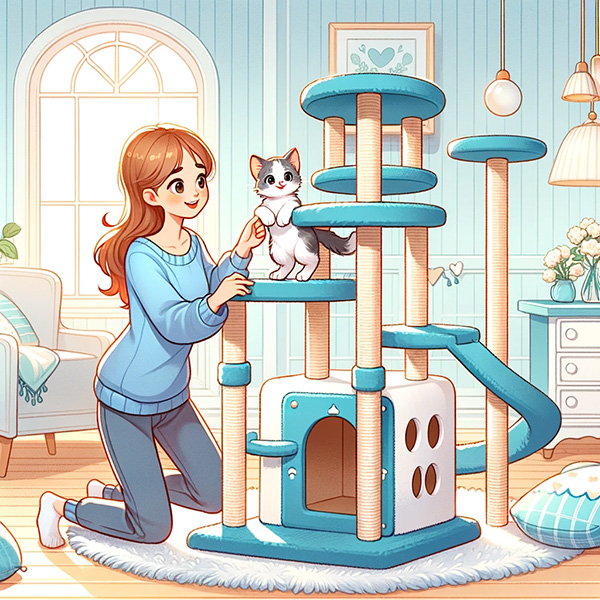Introducing a new cat to your current feline household is an undertaking that demands patience, strategic planning, and a good understanding of feline behavior. Cats are known for their territorial nature and individualistic behaviors and often require a carefully managed introduction to accept a new member into their domain.
Introducing cats to one another can be stressful. In this guide, we'll explore the intricacies of this process, ensuring a smooth and peaceful introduction that fosters a lasting bond between your feline family members. By understanding the cat psyche and respecting their need for space and time, owners can facilitate a harmonious integration that enriches the lives of their whiskered companions.
How To Introduce A New Cat To Existing Resident Cat
Preparation Before Arrival

Before you bring a new cat home, some preparation must be done. Setting up your home for a new cat involves creating a welcoming and safe environment that caters to the feline's instinctual needs. While you may already have the cat essentials from the existing resident cat, it is crucial to provide additional and new resources so there is no jealousy, competition, or marking scents for resources.
Start by designating a safe area where your new cat can retreat, feel secure, and gradually adjust to its new surroundings. This starting space could be a large bathroom or spare bedroom. This space must be distinct from the areas where your current cat usually spends time to avoid territorial disputes.
Prior to the cat's arrival, prepare this dedicated area with a new litter box and separate the cat's food bowl and water bowl. These items should be fresh and unused to avoid the resident cat's scent, which can potentially cause unease or stress in the new cat. Additionally, furnish this space with new toys and a comfortable bed to create a sense of security and comfort in an unfamiliar environment.
This initial setup plays a pivotal role in easing the transition for the new cat, allowing it to establish its own territory free from the existing cat's scent markers. Such measures are about physical comfort and providing a psychologically safe zone, which is crucial for the well-being of the new addition to your feline family.
For Kittens
The process of introducing a kitten to an adult cat may differ slightly from introducing two adult cats to each other. Instead of placing the kitten in a large bathroom or bedroom, the safe space can be a crate. The crate should be large enough to fit all the kitten's essentials and space to move.
It's important to avoid introducing a cat or kitten to a cat carrier by confining either to a cat carrier. This approach restricts their ability to retreat, which is essential for a comfortable and stress-free introduction. Cat carriers don't offer the necessary space for either animal to withdraw if they feel overwhelmed or threatened, which is crucial in maintaining safety and control during their first interaction.
Bring Your New Cat Home

Cats experience a sense of security when surrounded by their own scent. Transporting the new cat securely is crucial to ensure safety and minimize stress. Upon arrival, immediately place them in a pre-prepared area.
Introducing Scents

Scent swapping is pivotal in introducing a new cat to an existing resident cat. This should begin several days after the new cat's arrival. This practice entails swapping items such as bedding or toys between the two cats, enabling them to familiarize themselves with each other's scent before a direct face-to-face introduction. This method capitalizes on the feline's highly developed sense of smell, which is crucial in their social interactions and territory recognition.
Familiarizing each cat with the other's scent reduces the initial shock and potential aggression when they physically meet. The scent swapping should continue for at least a week after the new cat's arrival. This ongoing process helps to establish a sense of normalcy and mutual acceptance, laying the groundwork for a peaceful coexistence. It's a subtle yet highly effective strategy in easing the tension commonly associated with introducing a new member to the feline family.
Allow exploration of each cat's area

If the cats display a positive or neutral reaction to each other's scent on exchanged bedding and rubbed areas, an additional step can be introduced to ease the integration process further. This involves temporarily confining the resident cat, perhaps during nighttime hours, to a specific area, such as the owner's bedroom. This temporary confinement allows the new cat to explore the resident cat's usual domain without confrontation. However, this step should only be taken if it doesn't cause distress or frustration to the resident cat.
Alternatively, the new cat can be temporarily moved to a different secure location, granting the resident cat a chance to investigate the new cat's designated space. This approach should be considered only when the new cat appears completely at ease in its new environment, which might not be until several days after its arrival.
Both strategies are designed to foster gradual and stress-free acclimatization by giving each cat time to adjust to the presence and scent of the other within their shared living space. These measures are crucial in building a foundation for a peaceful and amicable relationship between the new and resident cats.
Controlled First Impressions

Controlled first impressions are vital in the delicate process of introducing a new cat to an existing resident cat. This stage typically commences after a few days of scent swapping once both cats have become familiar with each other's scent. The initial face-to-face encounter should be carefully managed, often through a barrier like a baby gate, screen door, or a slightly ajar door, allowing visual contact without physical interaction. Based on the cats' comfort levels, this controlled meeting should be brief, lasting only a few minutes, and gradually extended over subsequent days.
The significance of this step lies in its ability to gauge the cats' reactions to each other in a safe and controlled environment. Positive signs like curiosity or calm observation indicate readiness for closer interactions. Conversely, signs of aggression or extreme fear necessitate a slower approach. This methodical and cautious introduction helps prevent potential conflicts, laying a foundation for a calm and positive relationship between the new and resident cats. Ensuring these first impressions are managed correctly is crucial for a successful long-term integration.
For Kittens
If you are using a crate for your kitten, then at this point, you can allow the adult cat into the space where the kitten crate is located. Before you open the door, provide your kitten with a hiding space within the crate. This can be a cardboard box or an igloo bed. Offering a hiding space allows the kitten to retreat when it feels frightened or anxious.
As your other cat approaches the crate, it's best to provide both cats with treats to help ease their attention and provide positive association.
Supervised Interaction

Once a new cat and the resident cat are accustomed to each other's scent and show calmness during controlled first impressions, the next crucial step is supervised interaction. Depending on the cats' reactions, this phase typically begins a few days to a week after the initial introduction.
During supervised interactions, both cats are allowed to be in the same room but with the owner present to monitor their behavior. These sessions should start with short durations, around 10-15 minutes, and gradually increase as the cats become more comfortable with each other. Be sure to provide treats to both cats during the interaction. Also, try to keep the new cat away from the resident cat's favorite place initially to prevent any stress and conflict.
Supervised interaction is vital as it allows the cats to explore their relationship in a safe environment. The owner's presence ensures that any signs of aggression or fear can be immediately addressed, preventing negative experiences that could set back the introduction process.
If one cat shows aggression during the interaction, immediate and calm intervention is necessary. Aggressive behaviors can include hissing, growling, swatting, or physical altercations. In such instances, the cats should be gently separated into different rooms, using a blanket or a large piece of cardboard to avoid direct contact and potential injury.
This separation allows both cats to de-escalate and relax. It's a clear indicator that the introduction process might be progressing too quickly for one or both cats, necessitating a reassessment and possibly a slower approach. This could involve extending the scent-swapping phase or controlling visual encounters. Reintroduce their scents to each other through shared bedding or toys and consider feeding them on opposite sides of a door to build positive associations with each other's smell. Gradually and cautiously reintroduce the cats under close supervision, initially ensuring these sessions are brief.
Monitor for signs of stress and ensure there are designated safe spaces for each cat. If aggression continues or there's uncertainty in handling the situation, seeking advice from a veterinarian or a cat behavior specialist is advisable. Patience is essential in this process, as each cat adapts at their own pace to new social dynamics in their environment.
Free access without supervision for short periods

Progressing to a stage where the new cat and the resident cat can access each other without supervision marks a significant milestone in their introduction. This phase typically begins after several days or weeks of supervised interactions once both cats consistently display calm and non-aggressive behavior in each other's presence. Initially, these unsupervised periods should be short, lasting perhaps 10 to 20 minutes, gradually increasing as their mutual tolerance and comfort grow.
Allowing unsupervised access is crucial as it allows the cats to interact naturally and establish their relationship dynamics without human intervention. This step is crucial for fostering trust and understanding between the cats. It also provides insights into how they behave around each other in a more organic setting, which is key to determining the success of their cohabitation.
Introducing Cats Tips

Monitor Body Language
Vigilantly observing body language is vital when introducing a new cat to an existing resident cat. Cats communicate extensively through body postures, tail movements, ear positions, and facial expressions. Owners should observe signs of relaxation, such as a loosely held tail, upright ears, and general posture, indicating a positive response to the new companion.
Conversely, signs of aggression or fear, like flattened ears, hissing, a puffed tail, or an arched back, necessitate immediate attention and potentially slow down the introduction process.
Equal Attention
Providing equal attention to both the new and resident cats is crucial during their introduction period. This balance helps prevent jealousy and stress, which can arise if either cat feels neglected. Owners should ensure that both cats receive similar levels of affection, playtime, and care. This equitable distribution of attention reinforces positive associations with each other's presence and fosters a harmonious environment.
Consider Pheromone Diffusers
When introducing a new cat to a resident cat, consider utilizing pheromone diffusers as a helpful tool in easing the transition. These diffusers emit synthetic pheromones, mimicking the calming signals naturally produced by cats. Their use can significantly reduce stress and anxiety in both the new and resident cat, creating a more relaxed atmosphere conducive to positive interactions. For these reasons, it's best to place one where the resident cat spends time.
Consult a Professional
If you face persistent challenges or aggressive behavior, consider consulting a veterinarian or animal behaviorist for advice. Certain cats may inherently prefer living without other cats, and seeking advice from a professional can facilitate their coexistence, ensuring the best possible welfare for all involved.
Add Additional Litter Box
Adding an additional litter box in your home is crucial when introducing a new cat. A commonly recommended guideline is to maintain one more litter box than the number of cats in the household. Therefore, three litter boxes should ideally be provided for a household with two cats. This extra box ensures that each cat can access its own space for this essential activity, minimizing territorial disputes and promoting a harmonious living environment.
